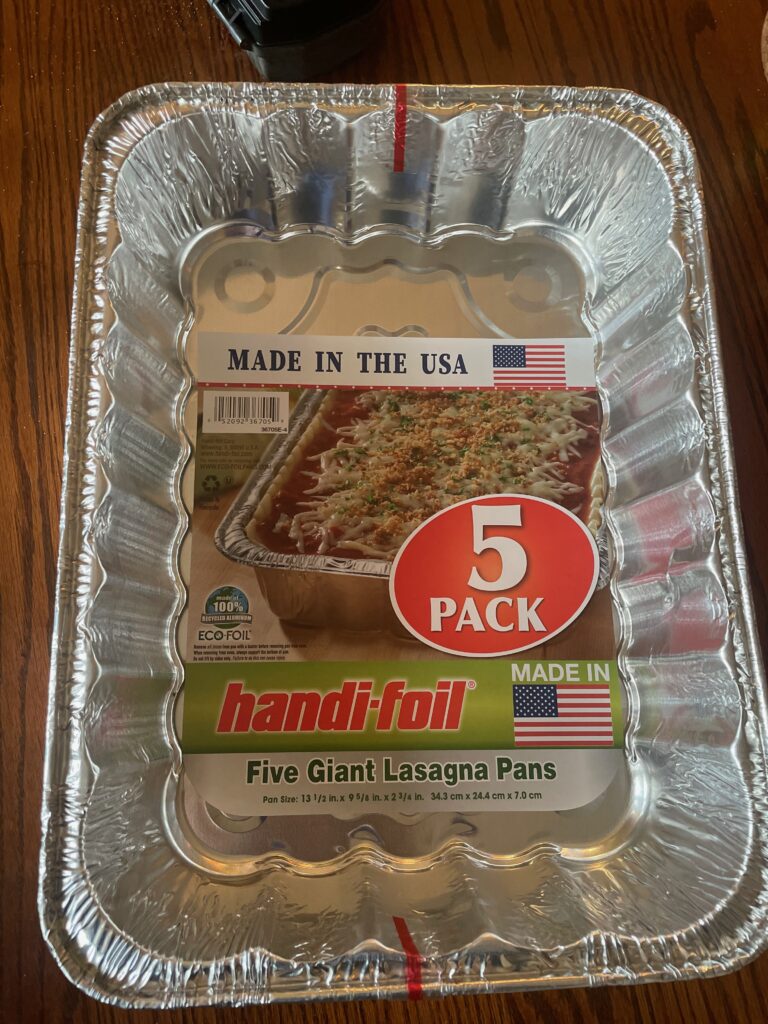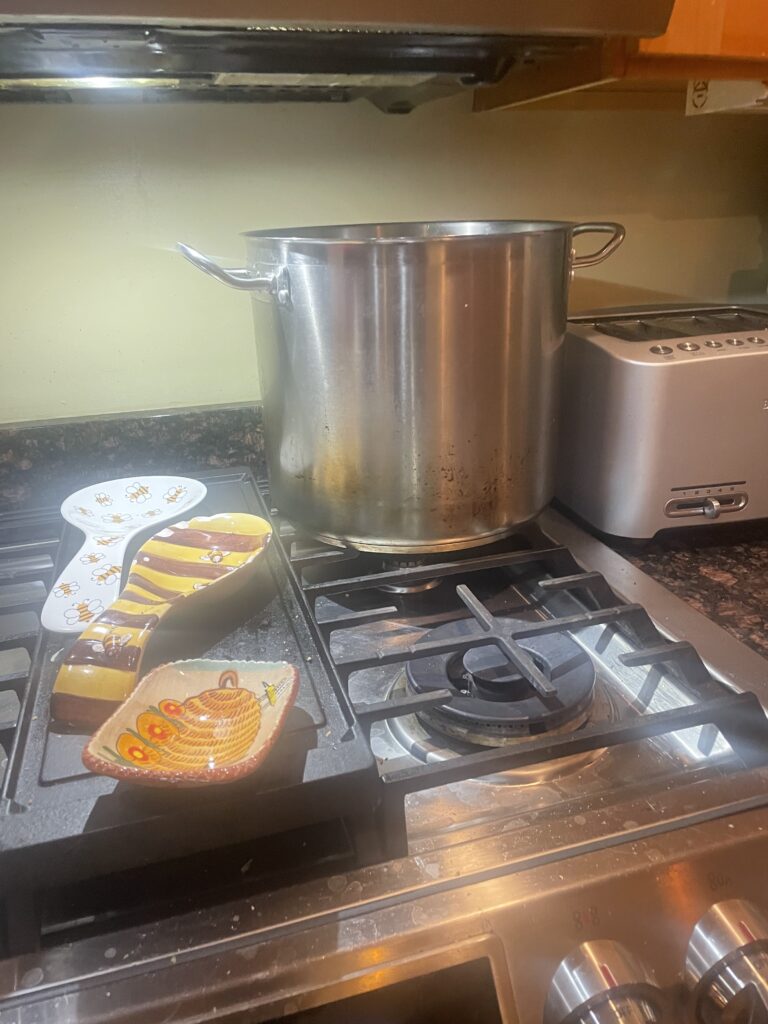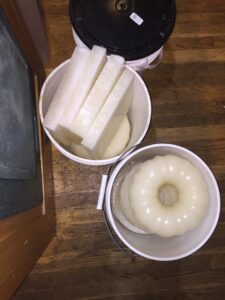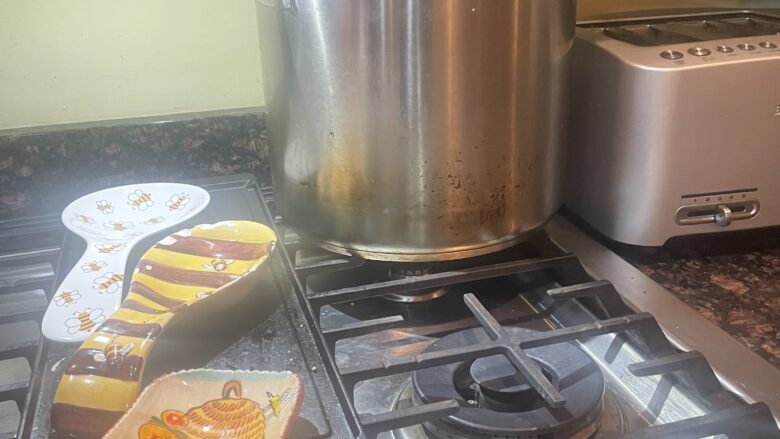Your mileage may vary, but mine have been chowing on this for years (with thanks to the Oregon State Beekeepers)
by Toni Burnham
We have had a dry October, with all the hopes of a Fall flow evaporating on the news that we may have a pretty cold winter, so (as a worried mother of sorts) my mind is already on emergency winter feeding. But this is how I roll most years, really,
One of my mentees and a couple of other beekeepers are going to come to my (disorderly) kitchen this Sunday and make about 200 lbs of fondant that we will split between the four of us and place on around 20 DC colonies this fall and winter. We will get this done with about two hours of cooking in two pots (and sipping, and talking bees) and everyone will go home with chunks of sugar that my bees have taken happily since 2007.
I will likely make about as much more in January.
Some of my favorite beekeeper altercations are the (goodhearted) conversations that happen around topics such as "You're an idiot to do it like that!" and "Your bees are doomed if you feed them that!" I am also well aware from recent years that I need to change up my game some. Beekeepers like Charlie Brandts and Wayne Esaias have made persuasive presentations to our club about the value of keeping just a bit of liquid food near the cluster and/or the candy as well. I would love to hear your opinion
Here's my (stolen, adapted) recipe and my process!
Ingredients
- 25 lbs White cane sugar (this is the size of the biggest bag from Costco that I can comfortably manage)
- 5 Cups water (measure this or end up with wet mush)
- 1+ Tablespoon apple cider vinegar (you don't need much)
- A teaspoon of sea salt (optional)

Directions
Set out your molds NOW. Hot sugar is like lava that turns into gravel. You want neither. I use cookie sheets, cake pans, bundt molds, and those aluminum pans you can buy at the grocery store for Thanksgiving or lasagna.

Put the water, vinegar and (optional) salt in big pot bring to a boil. When you get the contents to boil, l add half or a bit more of the sugar, stir and bring to a boil. At this point, try to make it just hot enough to boil, no more.
Once it is boiling again, add the rest of the sack, bring this to a boil again. (You know you are doing this right if the sugar you just added sorta floats and has to be convinced to mix with the rest).
The boil you are waiting for is "bubbly" boil" in the words of Andy Guest, who created this recipe. Mash it in and let it boil for 5 minutes. Sometimes I skimp on the 5 minutes and get away with it, but the candy "leaks."
Pour immediately into molds. If you let it set too long, it will come out lumpy. Please have your molds set up before you start.

I have used all manner of molds over the years: I find it helpful to have both thin and thick candy slabs in different situations. If I am using a medium as a shim to protect the candy when I place it on the top bars, I often use a bundt pan sugar loaf with a little slab from a cookie sheet over it: I dream that the bees are able to crawl up into the center and chow down, protected.
Andy Guest added this, though I have not explored it: "One other thing I found out. If you use bakers sugar it doesn't take so long to dissolve and you don't have to boil it for 5 minutes. Bakers sugar cuts the boil time down to 3-4 minutes."
Mr. Guest talks about making shims ("rims") for the purpose of placing these fondant loaves: "It does help to have a 1/2 rim around the top of your lid. I have almost finished putting the rims around my lids. I have a 120ish to go. I tried this last year on a much smaller basis and I have also found this candy sugar helps the hives."
I find that 1/2" is way too small for the amount of fondant I hope to place on my colonies. I have bees in too many places, and I like to leave 5-10 lbs on each in case weather turns against us and I can't get to all of them in time. I get more than 5 lbs in each lasagna pan.
Notes (THEY MATTER):
HOT SUGAR BURNS INSTANTLY.
Wait for the sugar to cool to room temperature if possible. You do not need to refrigerate.
If you are using molds that are "floppy" or could flex with hot sugar in them, don't move them unless you have a cutting board or other firm surface below on which you can transport them.
If you can safely transport the molds, I often stick them outside in cold weather to speed things up.
I added the sea salt to the recipe in order to make a hotter, shorter boil and to add trace elements. I may be an idiot, really.
You can keep the sugar loaves in the aluminum pans (if you use them) until you put them on the colonies.
When I transfer the loaves to buckets, they often "leak" some fluid. I consider this positive, as the bees need water to dissolve and access the calories in the sugar.
[Return to November 2023 BeeLine newsletter]

